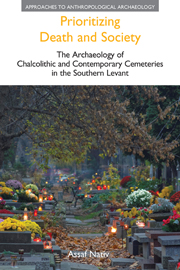 Prioritizing Death and Society
Prioritizing Death and Society from Part III - Contemporary cemeteries
Tombstone elaboration is a fairly common phenomenon, achieved by the application of a variety of figurative and structural additions, serving to enhance, refine or temper the elemental structure to which they are applied. The function of these additions seems to be subsidiary, supporting more specific modes of signalling that operate at a finer level than that of the tombstone itself.
In all, ten elements or motifs tend to recur:
Lantern — a structural element designed to house one or more candles. This feature is often observed in one of two forms: either (a) a relatively small tin or iron vessel with a door in the front and a domed “roof”, capable of containing one and possibly two candles; or (b) a relatively large structure, made of stone or tin and capable of containing a large number of candles at any given moment. Both forms may be found either in the front or the rear of the tombstone; the first variety is sometimes set into a predesigned recess in the tombstone.
Installation — a structure, usually with the upper part open, often encountered as a recess on the tombstone, although observed as an addition as well.
Chalice — a vessel made of plaster, ceramic or glass installed on or near the tombstone. These vessels are narrow and tall and are sometimes found in groups.
Book — an engraved stone addition, shaped like an open book, invariably located on the lower part of the tombstone.
[…]
To save this book to your Kindle, first ensure [email protected] is added to your Approved Personal Document E-mail List under your Personal Document Settings on the Manage Your Content and Devices page of your Amazon account. Then enter the ‘name’ part of your Kindle email address below. Find out more about saving to your Kindle.
Note you can select to save to either the @free.kindle.com or @kindle.com variations. ‘@free.kindle.com’ emails are free but can only be saved to your device when it is connected to wi-fi. ‘@kindle.com’ emails can be delivered even when you are not connected to wi-fi, but note that service fees apply.
Find out more about the Kindle Personal Document Service.
To save content items to your account, please confirm that you agree to abide by our usage policies. If this is the first time you use this feature, you will be asked to authorise Cambridge Core to connect with your account. Find out more about saving content to Dropbox.
To save content items to your account, please confirm that you agree to abide by our usage policies. If this is the first time you use this feature, you will be asked to authorise Cambridge Core to connect with your account. Find out more about saving content to Google Drive.